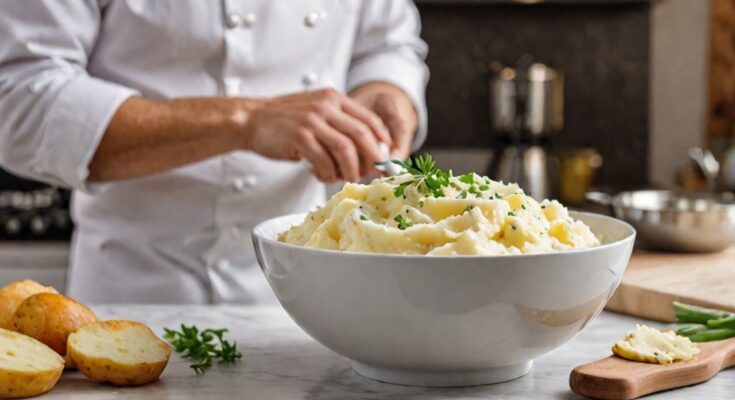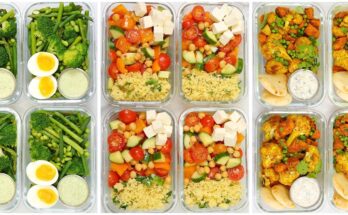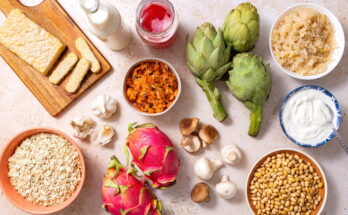Mashed Potatoe Recipe: Mashed potatoes aren’t just food—they’re a warm hug in a bowl. Creamy, fluffy, and buttery, they’ve held their place as one of the ultimate comfort dishes for decades. Whether it’s Thanksgiving, a Sunday roast, or a random Tuesday night, mashed potatoes have a magical way of bringing people together. Maybe it’s the smooth texture or the rich flavor, but there’s something nostalgic about them that reminds us of home-cooked meals and family dinners. They’re that familiar side dish that never fails to satisfy, providing the perfect backdrop to everything from roast beef to crispy fried chicken.
And let’s be real—there’s something so soothing about digging a spoon into a mound of steamy mashed potatoes. The way the butter melts over the top? Absolute heaven. It’s no surprise that they’re a go-to comfort food around the world. Plus, they’re incredibly customizable. Want it silky smooth? Go for it. Prefer a chunkier texture? No problem. Add-ins like roasted garlic, cheese, or herbs take it to another level entirely.
The Versatility of Mashed Potatoes
One of the best things about mashed potatoes is just how adaptable they are. Need a simple side dish? Done. Want to dress them up for a fancy dinner party? Easy. Craving something rich and indulgent or light and healthy? You got it. Mashed potatoes are a culinary chameleon, fitting in with almost any type of meal.
You can switch up the ingredients based on your dietary needs or flavor preferences. Don’t want dairy? Use plant-based milk and vegan butter. Watching your calories? Try a mix of potatoes and cauliflower. Want to impress guests? Stir in some gourmet cheese or fresh herbs. The possibilities are endless.
And let’s not forget leftovers! Mashed potatoes can be repurposed into potato pancakes, shepherd’s pie topping, or even stuffed into dumplings. They’re that side dish that keeps on giving.
Ingredients You’ll Need
Selecting the Best Potatoes
Not all potatoes are created equal, especially when it comes to mashing. The type of potato you choose can make or break the texture of your mash. For the fluffiest and creamiest result, russet potatoes are the gold standard. Their high starch content and low moisture make them ideal for absorbing butter and cream while still staying light and fluffy.
Yukon Golds are another excellent choice. They have a naturally buttery flavor and a slightly waxy texture, resulting in a rich, golden mash that’s a bit denser than russets but incredibly flavorful. Some people even like mixing russets and Yukon Golds to get the best of both worlds—fluffiness and flavor.
Avoid waxy potatoes like red or new potatoes if you’re going for classic mashed potatoes. These tend to be too firm and don’t break down as smoothly, which can lead to a gluey or lumpy result.
Additional Ingredients for Flavor
Here’s what you’ll need to make the perfect mashed potatoes:
- Butter: For that rich, creamy flavor. Use unsalted butter so you can control the saltiness.
- Milk or Cream: Whole milk works great, but for extra indulgence, use heavy cream or even sour cream.
- Salt & Pepper: Simple but essential.
- Garlic (Optional): Roasted or sautéed garlic adds a savory depth.
- Cheese (Optional): Sharp cheddar, Parmesan, or cream cheese can be stirred in for extra decadence.
- Fresh Herbs (Optional): Think chives, parsley, or rosemary for a burst of freshness.
Having all your ingredients ready to go before you start makes the process smoother and ensures you don’t miss anything.
Tools You Need in Your Kitchen
Making mashed potatoes doesn’t require a lot of fancy gadgets, but a few key tools make the job easier:
- Large Pot: Big enough to hold your potatoes and water without boiling over.
- Colander: For draining the cooked potatoes.
- Potato Masher: A basic hand masher works great for a chunkier texture.
- Ricer or Food Mill: For ultra-smooth, restaurant-style mash.
- Mixing Bowl: If you’re not mashing them directly in the pot.
- Measuring Cups and Spoons: Precision matters when you’re adding butter and cream.
Investing in a good potato ricer can seriously upgrade your mashed potato game. It ensures zero lumps and gives you that cloud-like texture that’s hard to beat.
Step-by-Step Guide to Making Mashed Potatoes
Step 1: Peel and Cut the Potatoes
Start by peeling your potatoes. A good vegetable peeler will save you time and effort. Once peeled, cut the potatoes into even-sized chunks—about 1 to 2 inches each. Uniform pieces ensure that all the potatoes cook at the same rate, so you don’t end up with some mushy and others undercooked.
Pro tip: Keep the peeled potatoes submerged in cold water if you’re prepping them ahead of time. This prevents browning and removes some of the excess starch, which can help avoid gumminess later.
Cutting the potatoes into smaller pieces also shortens the cooking time, which is especially handy if you’re in a rush to get dinner on the table.
Step 2: Boil Until Tender
Now it’s time to get those potatoes nice and soft. Place the cut pieces into a large pot and cover them with cold water. Starting with cold water ensures even cooking—if you drop them straight into boiling water, the outside will cook faster than the inside, which can lead to uneven texture.
Add a generous amount of salt to the water. This is your one big chance to season the potatoes themselves. Just like pasta, potatoes absorb flavor as they cook, and this makes a big difference in the final taste.
Bring the water to a boil over high heat, then reduce it to a simmer. Let the potatoes cook for about 15 to 20 minutes. You’ll know they’re done when you can easily pierce them with a fork or knife. Be careful not to overcook them, though. Too much boiling and they’ll absorb too much water, turning your mashed potatoes into soup.
Once they’re tender, it’s time to drain them well. Don’t rush this part—any extra moisture left behind can make your mash watery.
Step 3: Drain and Dry the Potatoes
After boiling, pour the potatoes into a colander and give them a minute to let the steam escape. This part is crucial. Letting the excess moisture evaporate ensures your potatoes will mash up fluffy rather than gummy.
If you want to go the extra mile, return the drained potatoes to the hot pot and let them sit on low heat for a few minutes. Stir them around gently to help any remaining moisture cook off. This step is a pro move that can really make a difference in the final texture of your mashed potatoes.
This quick drying technique is especially important if you’re aiming for creamy, restaurant-style mash. Too much moisture makes it harder for butter and cream to blend properly, which can mess with the taste and mouthfeel.
Step 4: Mash to Perfection
This is where the magic happens. Transfer the drained and dried potatoes to a bowl—or leave them in the pot if it’s easier—and start mashing. If you like your mashed potatoes rustic and slightly chunky, a handheld masher will do just fine.
But if you’re all about that ultra-smooth, cloud-like mash, a potato ricer or food mill is the tool for the job. These gadgets press the potatoes through tiny holes, creating a silky texture without any lumps. Plus, they make you feel like a pro chef, and who doesn’t love that?
Avoid using a food processor or blender. These machines are too aggressive and can turn your potatoes into a gluey mess due to overworking the starches. Trust us, it’s not the kind of creamy you want.
Once you’ve reached your desired texture, it’s time to bring in the flavor.
Step 5: Add Butter, Milk, and Seasonings
Here’s where mashed potatoes go from good to unforgettable. Add your butter first while the potatoes are still hot. This helps the butter melt evenly and infuse that rich, savory flavor into every bite.
Next, warm your milk or cream before adding it in. Cold liquids can cool down the potatoes too quickly and affect the texture. Slowly pour in the milk while stirring, stopping once you hit your preferred consistency. Some people like their mash thick enough to hold its shape; others want it silky smooth and almost pourable. It’s up to you!
Don’t forget to season. Add salt and freshly ground black pepper to taste. Taste-testing as you go is key here—what seems like enough salt in the pot might not be enough on the plate.
Feeling fancy? Add a clove or two of roasted garlic, a handful of shredded cheese, or a spoonful of sour cream for that extra zing. A sprinkle of chopped herbs like chives or parsley adds color and a burst of fresh flavor.
And just like that, you’ve made perfect mashed potatoes—from scratch and full of flavor.
Tips for the Creamiest Mashed Potatoes
Want to take your mashed potatoes to the next level? Here are some insider secrets for creamier, dreamier results:
- Use warm ingredients: Butter and milk should be warm or room temperature before mixing.
- Don’t overwork the potatoes: Gentle mashing preserves that fluffy texture.
- Add butter before milk: Fat first helps create a smoother emulsion.
- Use a ricer: For an ultra-fine, lump-free finish.
- Taste as you go: Balance the butter, salt, and milk as you mix.
Keep these in mind and you’ll have the kind of mashed potatoes people won’t stop talking about.
Common Mistakes to Avoid
Even a simple dish like mashed potatoes can go sideways if you’re not careful. To make sure your mash is always on point, watch out for these common pitfalls:
- Starting with hot water: Always start with cold water to ensure even cooking. If you throw potatoes into boiling water, the outside cooks faster, leading to uneven texture.
- Overcooking the potatoes: Leaving them to boil too long causes them to soak up water. This extra moisture results in watery, bland mash.
- Skipping the drying step: After boiling, don’t skip letting your potatoes steam dry. Extra moisture left behind makes it harder for the butter and milk to bind.
- Using the wrong tool: Never use a food processor or blender. These overwork the potatoes, turning them gluey. Stick to a masher or ricer for best results.
- Adding cold milk or butter: Cold ingredients can cool the potatoes too fast and ruin the smooth texture. Warm your milk and butter before mixing.
- Not seasoning enough: Under-salted mashed potatoes are dull and flavorless. Be generous and taste as you go.
Avoiding these mistakes ensures your mashed potatoes are restaurant-quality every single time.
Flavor Variations to Try
Mashed potatoes are the perfect blank canvas for all kinds of creative spins. Whether you want to wow dinner guests or just shake things up at home, these variations are sure to impress.
Garlic Mashed Potatoes
This version is a fan favorite. Roasted garlic adds a sweet, mellow flavor that transforms basic mash into something truly special.
How to make it:
- Roast a whole garlic bulb in the oven until golden and soft.
- Squeeze the cloves out and mash them with your potatoes.
- Mix in butter, cream, and a bit of Parmesan for added depth.
The result? Creamy, aromatic mashed potatoes that pair beautifully with steak, chicken, or veggies.
Cheddar and Chive Mashed Potatoes
Looking for something cheesy and savory? Add sharp cheddar and fresh chives for a flavor explosion.
How to make it:
- Stir in shredded sharp cheddar cheese while the potatoes are still hot.
- Mix in finely chopped chives for a pop of color and freshness.
- A dollop of sour cream makes it even more indulgent.
These are perfect for potlucks or holiday feasts and go great with BBQ or meatloaf.
Other fun ideas include:
- Wasabi mashed potatoes for a spicy kick.
- Truffle oil mashed potatoes for a touch of luxury.
- Bacon and green onion mash for a smoky, salty twist.
Don’t be afraid to experiment—mashed potatoes love bold flavors.
What to Serve with Mashed Potatoes
Mashed potatoes are one of those side dishes that go with almost everything. Here are some killer pairings that make a meal unforgettable:
- Roast Chicken or Turkey: Classic comfort food duo.
- Gravy-Smothered Meatloaf: The ultimate nostalgic meal.
- Grilled or Braised Short Ribs: Rich meats call for creamy sides.
- Salmon or Other Fish: Mashed potatoes offer a mellow contrast.
- Vegetarian Options: Try them with mushroom gravy, grilled tofu, or roasted veggies.
You can also use mashed potatoes as a base for shepherd’s pie or even breakfast hash. They’re endlessly adaptable, soaking up flavors and making everything around them taste better.
How to Store and Reheat Leftovers
Got leftover mashed potatoes? Great! They store well and are super versatile. Here’s how to keep them fresh and tasty:
Storage Tips:
- Let them cool completely before storing.
- Use an airtight container to avoid drying out.
- Keep them in the fridge for up to 4 days.
Reheating Tips:
- Add a splash of milk or cream to loosen them up.
- Reheat gently on the stovetop or in the microwave.
- Stir often to prevent sticking or uneven heating.
Mashed potatoes also freeze well. Scoop portions into freezer-safe bags, flatten them, and freeze for up to 2 months. Thaw overnight in the fridge before reheating.
Bonus idea: Turn leftovers into potato cakes. Just add an egg, some breadcrumbs, form into patties, and pan-fry until golden.
FAQs about Mashed Potato Recipe
1. What are the best potatoes for mashed potatoes?
Russet and Yukon Gold potatoes are ideal. Russets give a fluffy texture, while Yukon Golds offer a creamy, buttery consistency.
2. Can I make mashed potatoes ahead of time?
Yes! You can prepare them a day ahead and reheat with a splash of milk or cream over low heat to retain their smooth texture.
3. How do I avoid lumpy mashed potatoes?
Make sure to boil the potatoes until fork-tender and mash them while they’re hot. Using a potato ricer or masher also helps create a smooth finish.
4. What can I add to make mashed potatoes taste better?
Butter, cream, garlic, sour cream, or cream cheese all enhance flavor. Fresh herbs like chives or parsley also add a nice touch.
5. Are mashed potatoes gluten-free?
Yes, plain mashed potatoes made with just potatoes, butter, and milk are naturally gluten-free. Be cautious with any added flavorings or gravy.
6. How do I store leftover mashed potatoes?
Store in an airtight container in the refrigerator for up to 3–5 days. Reheat on the stove or microwave with added liquid to restore creaminess.
7. Can I freeze mashed potatoes?
Absolutely. Portion them into freezer-safe containers and freeze for up to 2 months. Thaw overnight in the fridge and reheat gently.
8. What’s the best way to mash potatoes—by hand or mixer?
By hand is better for a rustic texture. A hand mixer or ricer works for creamier results. Avoid overmixing to prevent gumminess.
9. Can I make mashed potatoes without dairy?
Yes, substitute with plant-based milk and vegan butter. Coconut milk, almond milk, or oat milk work well for creamy vegan mashed potatoes.
10. What dishes pair well with mashed potatoes?
They’re perfect with roast meats, gravy, grilled vegetables, sausages, or even as a topping for shepherd’s pie.
Conclusion
Mashed potatoes are more than just a side dish—they’re a soul-soothing staple that can elevate any meal. Whether you like them plain, cheesy, garlicky, or gourmet, mastering the basics and learning a few pro tips can take your mash from ordinary to unforgettable. With the right ingredients, techniques, and a little bit of love, you’ll always have a winning dish on the table. Now grab that potato masher and start whipping up some creamy, dreamy goodness.



